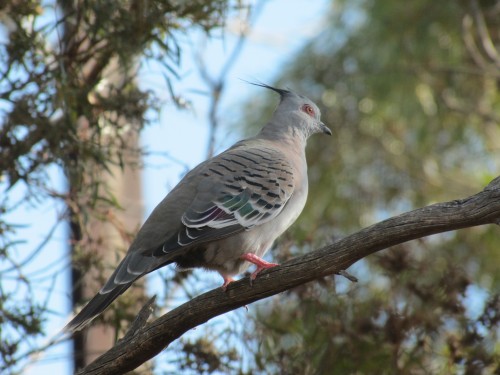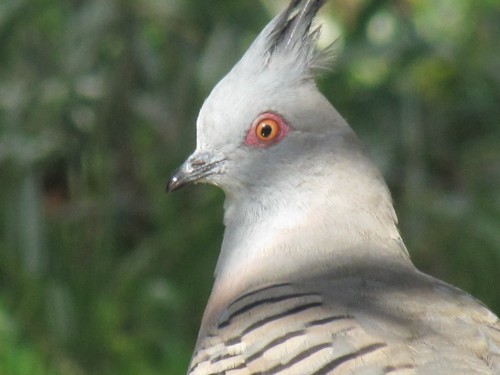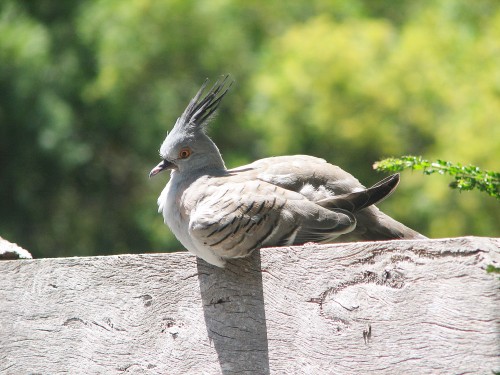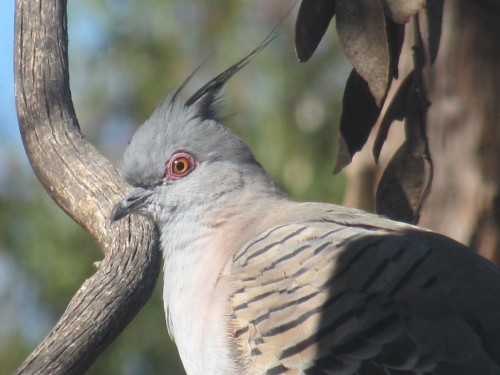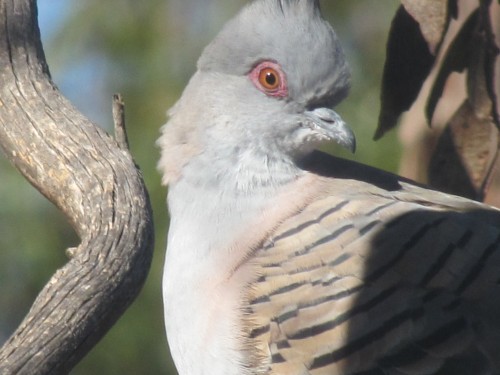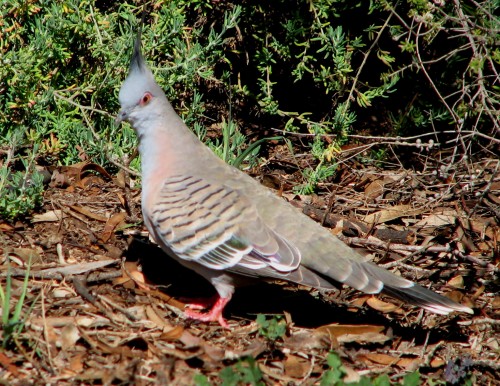Crested Pigeons, Botanic Park, Adelaide
Crested Pigeons are one of my favourite birds. We have a number resident in our garden and they have even nested several times within a few metres of our house. When the breeding season has been successful I have seen up to 35 Crested Pigeons sitting on the power lines running past our property. Elsewhere in Murray Bridge I have even seen about 60 in a loose flock sitting on power lines along the road.
Crested Pigeons are widespread throughout Australia except for the driest parts of the inland, southern Victoria and they are absent from Tasmania. They are also largely absent from the northern most parts of Australia. This distribution is changing and some Crested Pigeons can be found in the Melbourne region, for example, something that was rare as recent as a decade ago.
Crested Pigeons are ground feeders and can often be seen feeding in parks in loose flocks numbering in the dozens. This is the case in Botanic Park between the Adelaide Botanic Gardens and the Adelaide Zoo where the photos on this post were taken.
The birds in these photos were busy displaying to one another, more interested in breeding than in my wife and I having afternoon tea in beautiful park on a lovely spring afternoon.
Further reading:
- Crested Pigeon nesting
- Crested Pigeons by the dozens
- Birds in the garden plus one reptile
- A panic of pigeons
- Crested Pigeons as pet birds (one of my most popular articles)
- A crested Pigeon caught by surprise
Early morning walk
I’m just back from an early morning walk. It was about 15C, crisp fresh, no breeze and cloudless. A perfect morning for a walk.
As I was going along I was aware of several dozen Little Ravens calling nearby. I’ve been aware of many ravens calling near our home over the last week or so. It’s something they tend to do several times a year. They will gather in large numbers, often 30 – 50 or more and commence calling raucously for ten or twenty minutes or more. After a protracted chorus of their calls, especially near the house, one can feel a little annoyed; it can be a penetrating call up close.
I also observed about a dozen Crested Pigeons sitting on the power lines or feeding on the ground. Several of them were giving their elaborate bowing, bobbing and tail fanning display to prospective mates. This species seems to be always breeding around here. Probably why there’s a growing number of them.
We occasionally have lorikeets land to feed in the trees in our garden but more often they just fly over, very rapidly and very noisily. This morning a flock of 10 Purple-crowned Lorikeets went screaming overhead as I walked along, did a 360 turn wheeling around to check me out (or maybe the mallee tree on the side of the road) before streaking off to find another tree in blossom. It’s like having a miniature squadron of fighter jets fly over at close range. The photo below shows a related species, the equally noisy Musk Lorikeet which we also get here from time to time.
Crested Pigeon nesting
About three weeks ago I was walking the estate. (We live on a five acre block on the edge of town.)
As I passed a row of Hakea francisiana bushes I checked thoroughly for any bird nests. These bushes, which are about four metres high, often host pigeon or honeyeater families.
Sure enough, a Crested Pigeon was sitting on a nest. I quietly crept away, knowing how easily pigeons can be disturbed from their nests. Sadly, when I checked back last week, the nest was abandoned. Even sadder was the half grown chick hanging from a fork in a branch. It was dead.
Something must have disturbed this young chick which then tried to escape, only to hang itself. The culprit could have been an Australian Magpie (they are feeding young at present), a Grey Currawong ( who will take young from a nest to feed its own), a Brown Falcon (which has been harassing the local birds recently) or even a Little Raven.
On another sad note, today when working in the scrub I found the wing of an adult Crested Pigeon. There was no evidence of who had taken this poor creature.
Nature in the raw can seem so cruel. But then – I could name a few humans who are not exactly innocent of cruelty.
Crested Pigeons as pet birds
I recently had a rather interesting comment on an earlier post of mine about Crested Pigeons (see Great Birding Moments #5 Crested Pigeons).
Karen wrote:
I have a crested pigeon sitting on my shoulder at the moment. I went for a walk one morning and saw her on the footpath. She ran towards me, not usual pigeon behaviour. I picked her up, she cooed and closed her eyes. I took her home and fed her and she has stayed. She follows me around the house and is the most inquisitive bird I have ever known. She is quite content to be scratched around the head and calls to me whenever I enter the room. She was obviously someone’s pet but I had no success in locating them. I originally had intended to feed her up and let her go again but she is so tame she would have been a danger to herself. She lives with my 3 cockatiels and probably thinks that she is one.
What an amazing experience! Karen is certainly right in deducing that it is someone’s pet, because the behaviour is certainly consistent with a bird that has been used to being handled.
Crested Pigeons are reasonably common in aviculture, especially in zoo collections. This species normally requires a large planted aviary and will breed readily in captivity.
I find it interesting that it is quite at ease in her home and with the Cockatiels. It must make her day very pleasant to have such a lovely team of bird friends to keep her company.
She is probably right that it is safer in her home rather than fending for itself in the wild. If released, it would probably be taken by a hawk very quickly as it would not be as alert to the dangers presented by living life in the wild.
Please note: the laws about keeping native Australian birds in captivity varies from state to state. Please check with the relevant authorities before adopting birds. Your state National Parks and Wildlife website is a good place to start. You local pet shop should also be able to help.
Update: This article was edited and updated in July 2015. The photos below were also added.
Great Birding Moments #5 Crested Pigeon
Earlier this week while driving to the post office to post some letters, I saw about a dozen Crested Pigeons Ocyphaps lophotes sitting on a powerline. This is a relatively common sight here in my home town of Murray Bridge in South Australia. I have seen loose flocks of 20-30 sitting in rows on power lines or on fences. On several occasions I have counted over 40, with 48 being the highest number in one spot.
Resident Breeding Species
The Crested Pigeon is a resident breeding species in our garden on our five acre block of land on the outskirts of Murray Bridge South Australia. On one occasion a pair nested only five metres from our house, in full view from the sun room where we often eat or sit and read or entertain visitors. The nest is a flimsy platform of small twigs. It is amazing how this poor excuse for a nest holds the eggs, let alone contain several growing chicks. But it is simply palatial compared to another common species around here. The nest of the Common Bronzewing Pigeon has so few twigs that I have been able to stand underneath one and count the eggs!
A bird on the move
The Crested Pigeon historically has been a species of the inland parts of Australia. In recent decades, however, it has spread steadily due in part to the increased availability of water on farms. It is very common in the parks and gardens of Adelaide and is increasingly reported in the metropolitan areas of Melbourne. In southern South Australia it was rarely seen in the south east districts, but I have seen it only a few kilometres from the coast near Mt Gambier.
Habitat
It has been a bird of the rural areas of Australia, inhabiting grasslands, pastures, cropping areas, roadsides and farmyards. More recently it has become common in parks and gardens, golf and race courses, sporting grounds and other urban areas, even in our larger cities.
Common Name
I grew up in the Murray Mallee farming district in South Australia. Throughout this area – and in many other parts of Australia, this species is still called a Topknot, noting its erect crest. This confuses it with the Topknot Pigeon of the rainforests and woodlands of eastern Australia.
I must admit that this is one of my favourite species. It seems such an endearing bird and will allow a close approach to within a few metres if done without sudden movements, especially at the nest (which I try to avoid doing too often). Up close, with the sun on the feathers, one can fully appreciate the stunning beauty of the iridescent colours on the wings.










